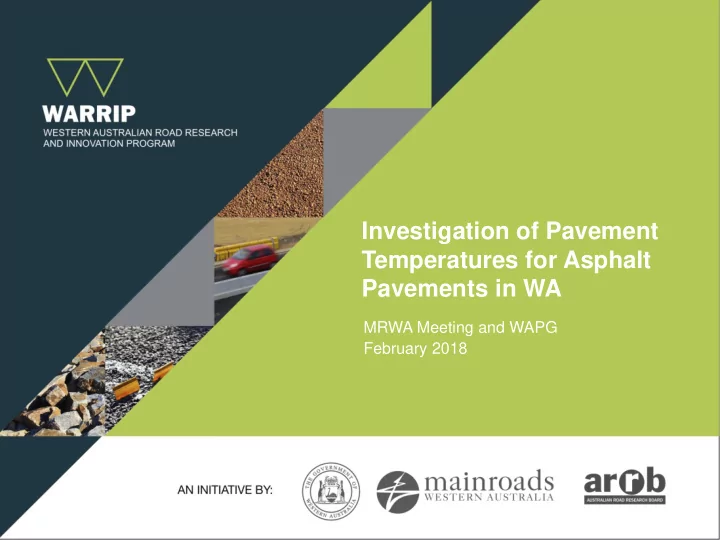

Investigation of Pavement Temperatures for Asphalt Pavements in WA MRWA Meeting and WAPG February 2018
42 °C Introduction 40 °C • Predicted pavement temperature is a major component in our 40 °C current design methodology through the WMAPT value • WMAPT does not consider: 34 °C • asphalt thickness • underlying material properties • localised weather 31 °C • climate trends 30 °C 29 °C 26 °C 24 °C
Previous projects • Curtin University instrumented two pavements on the Great Eastern Hwy • Two sites at EME2 trials • Sites cover high proportion of climate zones in Australia
What did we do? • Installed on Kwinana Freeway near Berrigan Drive overpass in Jandakot in Sept 2016 • Six temperature probes at depths of 45mm down to 320mm • Linked to weather station with sensors for ambient temperature, solar radiation, rainfall, humidity, wind speed • Data provided over 4G modem to live web portal, downloaded monthly and analysed before being sent to MRWA
Observations
Observations 45 40 35 30 Pavement Temperature ( º C) 25 20 15 Brisbane 50mm Brisbane 200mm 10 Perth 45mm Perth 200mm 5 South Gippsland 55mm South Gippsland 185mm 0 12 AM 2 AM 4 AM 6 AM 8 AM 10 AM 12 PM 2 PM 4 PM 6 PM 8 PM 10 PM 12 AM
Observations 30 25 20 15 10 5 0 Perth -5 0 5 10 15 20 25 30 Daily solar exposure (MJ/m 2 )
Observations
Observations • Surface temperatures vary by location across road Breakdown lane Left Lane Middle lane 5-8 ° C lower 8+ ° C lower Highest temp. Edgeline 1-4 ° C lower
Implications for design • Climate change has led to growth in temperatures over last 70 years • WMAPT have not been adjusted upwards • ‘Average’ WMAPT in Perth over 40 -year design life should be 31 ° C • Equivalent to reduction in design life of 17% (7 years of design traffic)
Implications for design • WMAPT was adopted from the Shell Pavement Design Guide (1978) • How does this compare to temperatures at the instrumented site? • Average annual pavement temperature (similar for all depths) is 25.3 ° C • Closest methodology is to adjust Methodologies for calculating WMAPT – Perth 2016/17 for recent climate data, then use Average annual pavement temperature at 100 mm ( ° C) 25.3 the Shell PDM chart but WMAPT ( ° C) 29 Austroads WMAPT (2017) interpolate for the correct depth Offset to actual ( ° C) 3.7 WMAPT ( ° C) 28.2 Calculate WMAPT from 2016/17 weather station data Offset to actual ( ° C) • 2.9 Same holds true for data from WMAPT ( ° C) 26.8 South Gippsland and Brisbane Shell PDM Chart RT (correcting for depth) Offset to actual ( ° C) 1.5 WMAPT ( ° C) 26.0 Shell PDM Chart RT (2016/17 weather station data) Offset to actual ( ° C) 0.7
Implications for design - Examples Thick pavement = 300mm Thin pavement = 100mm 3.5E+08 3.5E+06 Thick pavement fatigue life (ESA) Thin pavement fatigue life (ESA) 3.0E+08 3.0E+06 2.5E+08 2.5E+06 2.0E+08 2.0E+06 1.5E+08 1.5E+06 1.0E+08 1.0E+06 5.0E+07 5.0E+05 0.0E+00 0.0E+00 18 20 22 24 26 28 30 32 34 WMAPT ( o C)
Implications for design - Examples • Generic thick pavement at various temperatures 28 ° C 30 ° C 32 ° C Wearing course 30mm Wearing course 30mm Wearing course 30mm Asphalt 364mm Asphalt 350mm Asphalt 336mm Granular 250mm @ 250MPa Granular 250mm @ 250MPa Granular 250mm @ 250MPa Subgrade CBR 10 Subgrade CBR 10 Subgrade CBR 10
Implications for design - Examples • Generic thin pavement at various temperatures 28 ° C 30 ° C 32 ° C Wearing course 30mm Wearing course 30mm Wearing course 30mm Asphalt 75mm Asphalt 70mm Asphalt 61mm Granular 500mm @ 500MPa Granular 500mm @ 500MPa Granular 500mm @ 500MPa Subgrade CBR 10 Subgrade CBR 10 Subgrade CBR 10
Modelling • Several models have been proposed previously • A model with relatively simple inputs and outputs can improve accuracy of our fatigue life predictions INPUTS OUTPUTS Daily maximum air temp. (BoM) Maximum pavement temp. at any depth Daily minimum air temp. (BoM) Minimum pavement temp. at any depth Daily total solar exposure (BoM) Four constants ( α , β , γ , δ ) Pavement depth Sunrise/sunset times (day/night mode) 𝑏 max) + 𝛿 ∗ 𝑇𝑆 𝑈 𝑞 𝑛𝑏𝑦 𝑏𝑢 𝑒𝑓𝑞𝑢ℎ 𝐸 = 𝛽 + 𝛾 ∗ (𝑈 1000 + 𝜀 ∗ 𝐸 𝑏 min) + 𝛿 ∗ 𝑇𝑆 𝑈 𝑞 𝑛𝑗𝑜 𝑏𝑢 𝑒𝑓𝑞𝑢ℎ 𝐸 = 𝛽 + 𝛾 ∗ (𝑈 1000 + 𝜀 ∗ 𝐸
Modelling • Use max & min daily pavement temp. and two part function to calculate hourly pavement temperature • Sine curve during daylight hours, proportionate drop-off during night • Merge with traffic distribution from WiM site or counter • Calculate fatigue life estimate based on 8760 (=24*365) data points
Benefits of this approach • We have a more localised and accurate understanding of the pavement response to climate and traffic • Compatible with mix-specific fatigue relationships and changes to Austroads methodology • May not be suitable to all projects but relevant when looking at major projects
Summary • Project due for finalisation in June 2018 • Second instrumented site planned for later in 2018 or early 2019 Continuous monitoring until at least end of 2 nd full year at each site •
Recommend
More recommend